#V/STOL fighters
Explore tagged Tumblr posts
Text
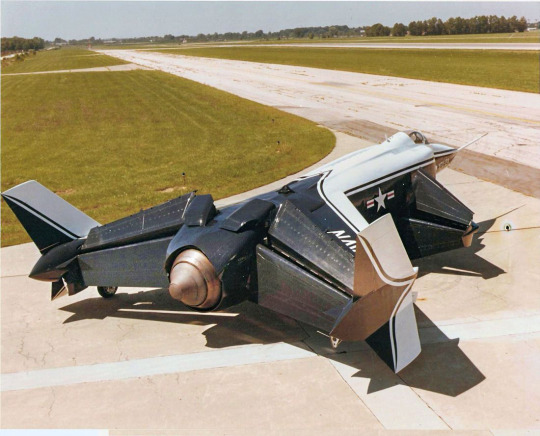
Rockwell XFV-12A
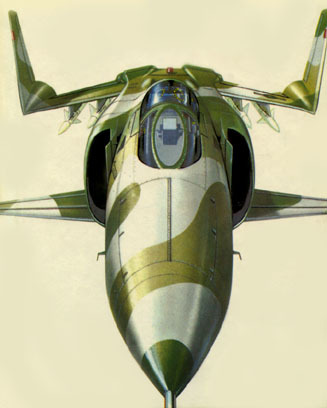
Rockwell XFV-12A
by Alex Stoll

Around 1970 the Navy could not see how it was going to be able to replace its old Essex and Midway carriers with Nimitz-class supercarriers. Admiral Elmo Zumwalt directed a study of alternatives which resulted in the Sea Control Ship (SCS), a mini-carrier equipped with V/STOL fighters and ASW aircraft. The USN invited manufactures to propose demonstration programs for a new aircraft, called the V/STOL Fighter Technology Prototype, to replace the outdated Harrier and serve on the SCS or other ships much smaller than conventional carriers: BAe and MD proposed an improved Harrier and a supersonic Harrier with a PCB (Plenum-Chamber Burning) engine; Boeing and Northrop proposed jet-powered tail-sitters; Lockheed-California proposed a propeller-driven tail-sitter; and Rockwell proposed a canard-delta aircraft powered by a large and enormously powerful engine that used the ejector-lift system for V/STOL. The Navy awarded the contract to Rockwell in 1972, instead of choosing designs based on proved technology, and the XFV-12A designation (twelth in the V series, not in the F series; the F-12 was the interceptor verison of the Blackbird) was allotted. Even though the forward fuselage and landing gear of the A-4 and the wing box, air intakes, and fuel tanks of the F-4 were used to speed the program up, it still ran far behind schedule. The prototype was rolled out in December 1976 and the first flight was scheduled for 1979.

Engine Configuration For takeoff and landing, the entire engine was ducted to hollow-section "ejector flaps" (also called augmentor flaps) out along the wings and the canard by pilot command via a diverter valve box. The high-energy hot gas forced fresh air from above through the ejector flaps at a ratio of 7.5:1 to boost thrust by 70 percent. The ejector flaps could be raised or lowered to provide a smooth transition from vertical to horizontal flight or vice versa. After the XFV-12A's cancellation, de Havilland Canada designed an aircraft with ejectors build into the roots of a delta wing. GD incorporated their concept into the E-7, a F-16-based delta-winged STOVL aircraft. DHC built a large powered model and tested it in 1987. The EL system was large and control was difficult as a result of the large air mass moving through the wing root during transition, and nothing came of it (though not because the EL couldn't produce enough thrust as in the XFV-12A's case) despite the attractive low exhaust velocity.

Cancellation Rockwell and Pratt & Whitney experienced several major technical problems, and the thrust boost from the ejector flap system was never as large in the full-scale aircraft as predicted from data collected by test rigs and sub-scale models; the XFV-12A could not leave the ground. Eventually funding dried up, the SCS was canceled, and the program proved a disappointment; however, in most future ASTOVL programs, large-scale powered models were used because of the experience gained in the XFV-12A program.

124 notes
·
View notes
Text

British Aerospace Sea Harrier
6 notes
·
View notes
Text
The V/STOL fighter jet is the sort of exercise in hubris and wasted money you can only get out of the dumbest empires
20 notes
·
View notes
Text

'Digital Harrier' XW175 was used to test a new computerised flight control system intended for a next-generation V/STOL fighter - which would eventually end up being the F-35.
@Tempest_Books via X
119 notes
·
View notes
Text
Lore Thursday — Falcata
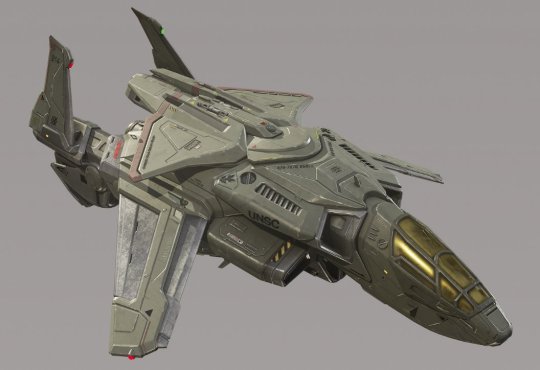
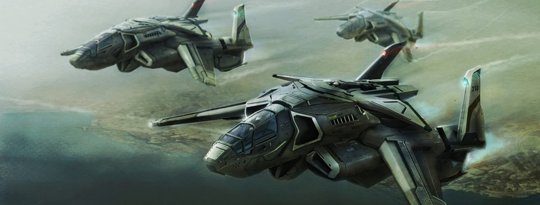

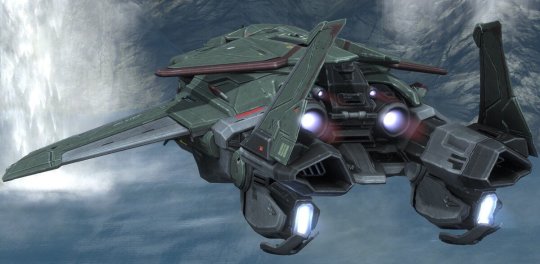
The F-23 Falcata is a heavy V/STOL atmospheric fighter operated by the UNSC Air Force early in the Human-Covenant War. Ultimately supplanted by the S-14 Baselard, surplus Falcatas have found a niche in planetary defense forces.
#lore thursday#LoreThursday#halopedia#halowiki#halo wiki#halo#haloreach#halo reach#halowars#halo wars#unsc#unscvehicle#unsc vehicle#unitednationsspacecommand#united nations space command#halocutvehicle#halo cut vehicle#halocutunit#halo cut unit#falcata
19 notes
·
View notes
Text
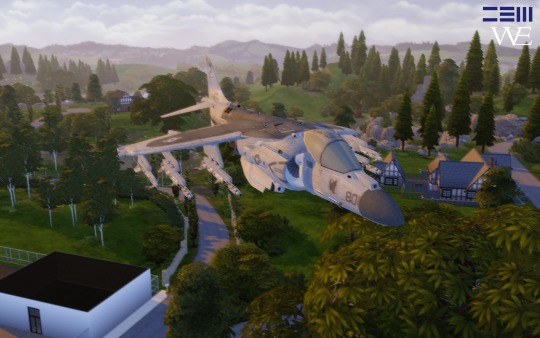
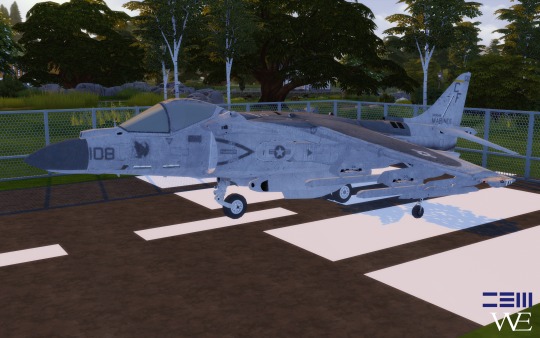
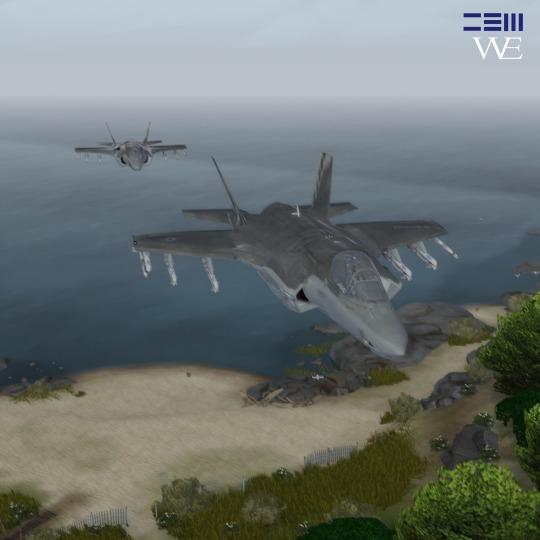
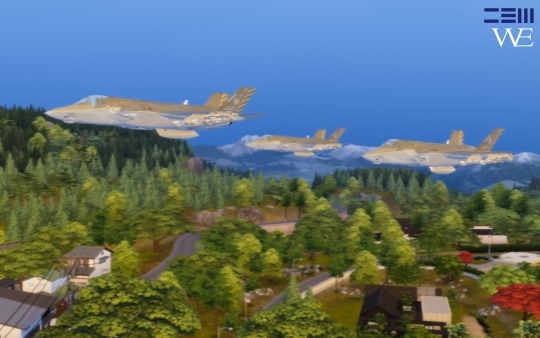
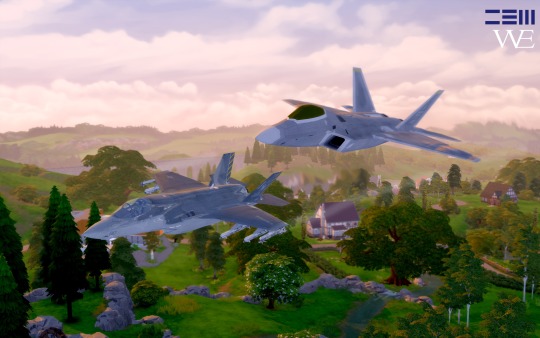
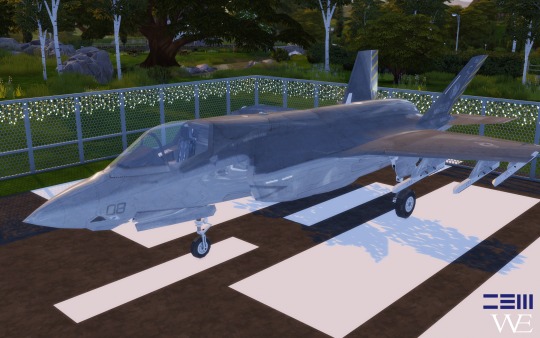
STOVL Fighters Collection DOWNLOAD
At the end of 1950s, the engineers had just an idea of delivering the aircraft even without a runway. Then in the beginning of 1960s, some tests conducted to test the capability of STOVL (Short Take-Off Vertical Landing) or in other word, a possibility of vertical movement of the fixed-wing aircraft, began with the "Flying bunk" in1959. Then the Hawker Siddeley Limited in Britain proposed a concept named "P1127 Kestrel" as a prototype of the VTOL fighter. Then this concept acepted and in 1969, the production of Harrier GR1 had begun. This aircraft was intended to be in use for Royal Air Force, but the Royal Navy also got their own version of FRS1 years later. These Harriers sought it's first battle experience in Falklands War in 1982 when these Harriers brought down some of the Argentine's air capability without any losses. The last of the Harrier production was in GR9 variant which subsequently substituted by the latest F-35B by the Royal Air Force.
McDonnell-Douglas AV-8B Harrier II
The USMC was also seeking the aircraft that suits for the amphibious mission. After the success of the Harrier FRS1 and GR3 variants in the Falklands War, in 1985 the USMC proposed an inquiry to acquire some of these aircrafts, with also stated that these aircrafts should be manufactured in the United States. Then BAe Industries licensed the Harrier to the McDonnell-Douglas company . Also this aircraft met the service within the Royal Spanish Navy in 1987. Several missions has been done by AV-8Bs including Gulf War, Operation Enduring Freedom, Operation Iraqi Freedom and Libyan Crisis.
Lockheed Martin F-35B
The STOVL variant of F-35 Thunderbolt which it's STOVL technology derived from Yak-141 VTOL system, which sold to the Lockheed Martin in 1992, which emphasizes the vector exhaust and a fan in the middle of the aircraft. Also the most wanted aircraft in action of this century. The F-35B is the short take-off and vertical landing (STOVL) variant of the aircraft. Similar in size to the A variant, the B sacrifices about a third of the A variant's fuel volume to accommodate the SDLF. This variant is limited to 7 g. Unlike other variants, the F-35B has no landing hook. The "STOVL/HOOK" control instead engages conversion between normal and vertical flight.The F-35B is capable of Mach 1.6 (1,976 km/h) and can perform vertical and/or short take-off and landing (V/STOL)
#the sims 4#the sims#the sims 4 custom content#ts4 cc#ts4military#the sims 4 military#ts4#the sims 4 cc#ts4cc#deus ex machina#the sims 4 decades challenge#ts4 decades challenge#sims 4 decades#early 2000s#late 2000s#2000s style#fighter jet#f 35 lightning ii#british#american
29 notes
·
View notes
Text
Microsoft Flight Simulator 2024 Game for PC
Microsoft Flight Simulator 2024
The bunch additionally called up, or entered, to help every glider international airport within the whole humankind with founded the very first data bank to road them. Large make up that will present a good aviation threat include what's often known as the "OB", "blockage fun" around the top. You realize those crimson gentle the truth is happening radio systems? MSFS 2024 has typed spanning a zillion ones right now, all through the world.

That incorporates a artwork engine enhance and also compatibility with preview DirectX 10 and Interface Windows vista. It absolutely was announced on March 17, 2006, within Northern The us. You will find a couple descriptions from the tough, both at a couple of DVDs. The several latest versions combine sophisticated climate simulation, along with the chance to download real-world climate data (first offered with Airfare Simulator 2000). The a couple of latest models associated with Microsoft Trip Simulator have a very "kiosk function", that permits the approval to get direct within digital kiosks found in general public space like shopping shopping center.
This particular extra entertainment ends up being really being a “digital two” with the really incident. Here minute 2007, Experts Online game Studio announced the statement involving ticket to make use of Microsoft Enterprise Simulation Podium, the engine which in turn Microsoft Journey Simulator X will depend on, in order to guests who would like to use the technologies to produce solution. Lockheed Martin announced that this new solution based on the ESP supplier policy could be named Prepar3D, a simulation tool intended for students, forces and also commercial operators to utilize generally just as one open entire world simulator. Lockheed Martin retained the services of limbs of the unique Aces Activity Business staff to stay more education from the solution. Microsoft generated a new program load up for Airline flight Simulator X comparable clock since the growth wrap up.
In a variety of locations during the entire time, "a person will discover different material, but also they're migrating," thus in which a person corner a herd associated with wildebeests as well as caribou eventually may not be identical home you discover them your next. If you’re nonetheless online game, top mfs2024fans.site to the site the signup sheet in addition to angry your handle. And casual users could experience the simulator through solving brief sightseeing airfare also exploiting the revolutionary photography manner.

Data Used to Monitor You
Although STOL competitors don’t really occur in the real-world, Wolf explained. They materialize inside Microsoft Journey Simulator as well by having a parallel reasonably competitive collection call up Country wide eSTOL. A true image involving aerial combat; regarded through allies and also feared through opponents. The Fw 190 A-8 stands for the peak involving German born radial serps fighter goal and shelf among the almost all fearsome airplane regarding World Battle II. Hated by lots of, the Fw 190 verified the really do the final opponent to be able to Spitfire Mk V; dominating the airs over Philippines like a fighter while likewise show itself important being an interceptor, gaining a terrible name amongst Allied bomber crews. The programmer, RORTOS SRL, revealed which the app’s privacy systems can consist of naming involving data seeing that described down below. For more info, grasp the designers privacy coverage. Microsoft Flight Simulator 2024 is scheduled to get published Nov. 19 upon Windows PROCESSOR in addition to Xbox Line X. Dependant on a rapid glance at the Water hardware review, I’d suppose on 2 pct regarding stream COMPUTER SYSTEM gamers in very best can meet the item.
With The fall of 2010, Lockheed Martin debuted Prepar3D type 1.18 Variation 1.1 ended up being liberated within The spring 2011, using a full price license rate of US$499.19 A creator license is also designed for a regular monthly payment involving US$9.95. With Advance 2012, combined with publication regarding variation 1.3, the charge approach was modified. The Pro magazine ends up being currently readily available for US$199, having an Academic Freedom intended for US$59.95.
Microsoft Airline flight Simulator 2024 is usually a pretty significant good results during online game development, according to a critique I witness on the match here Illinois for the Grand Canyon, due to Microsoft. Currently I’m not really moral state of which mainly because I got in order to flutter in a in their associate’ tiny aircrafts. The Rushing load up increase more plane – Agusta Westland AW101, Boeing F/A-18 Hornet, plus a pursuit version of the P-51D Mustang. The up-date becomes mostly intended for Windows vista consumers of which allowed DirectX 10 agreeable image adapters. This particular model acquires benefit from DX10's boosted shader style plus much more pixel pipelines also encouraged presentation for Landscape, approaching entire FSX show on XP. Participants with SP1 may insert a meeting with persons who've SP2 or even Rushing with Multiplayer. In order in order to install SP2, SP1 ought to happen installed previously. Take to the heavens with involve yourself in a impressive soaring skill with the flight sim sticks and items intended for LAPTOP OR COMPUTER, Xbox and PlayStation. From military in addition to civilian jet to help freedom simulation, our own product or service become created for most proficiency direct and travel personal preference.
Within 2024, Microsoft Journey Simulator is letting us are now living in it. Behind my first time playing Microsoft Airfare Simulator 2024, though, I'm honestly much more motivated for MSFS 2024 than I was present soon after How to Download Microsoft Flight Simulator 2024 my personal first hands-on with the 2020 video game all 5 years ago. The Logitech G sort of panels may be situated one particular together with one more before side-by-side. Easy-to-use bracket segments give you the means to fix your current departure simulation group within a configuration just restriction from your curiosity. In the same manner, a fresh wedding photographer manner creates a valuable small minigame on the face.
1 note
·
View note
Text

V/STOL fighter concept
6 notes
·
View notes
Text
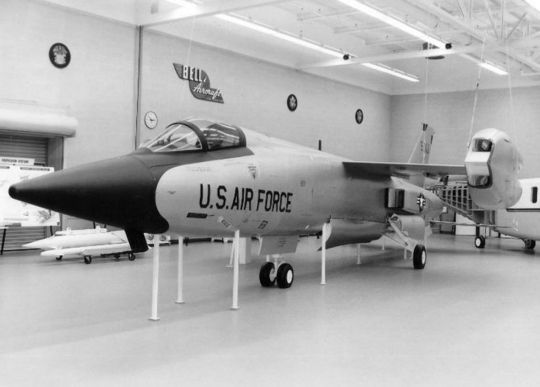
-The mockup Bell D-188A in USAF markings. | Photo: Bell Aircraft
FLIGHTLINE: 157 - BELL D-188/XF-109/XF3L-1
The result of a joint USAF/USN request for a supersonic V/STOL fighter-bomber, the D-188A was canceled before progressing beyond a single mockup.
The genesis of the plane, known internally as Bell Model 2000, was in a 1955 joint request by the Air Force and Navy for a new V/STOL aircraft capable of Mach 2, which would act as a fighter-bomber for the USAF and a fleet defense interceptor for the Navy. The design was highly ambitious and unconventional, with a long fuselage mated to high, short wings that terminated in rotating nacelles holding two engines each. The aircraft would have six or eight J85 engines total depending on the model, four on the wings, two in the tail, and two more optionally in the forward fuselage for vertical thrust. The Navy model would also incorporate a bleed air system to enhance vertical lift and maneuvering.
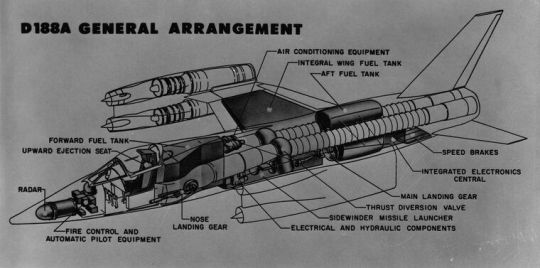
-Cutaway drawing of the six-engined D-188A variant. | Illustration: Bell Aircraft
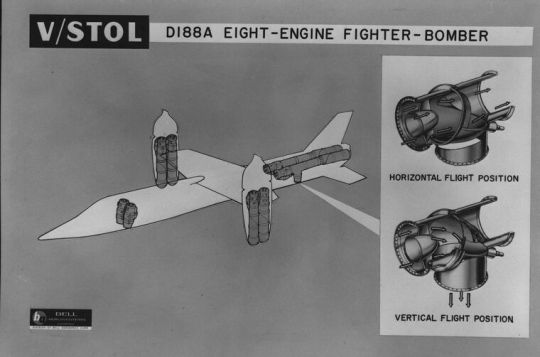
-A more simplified drawing of the eight-engined variant, showing the forward pair of lift jets and the vectoring of the aft nozzles for vertical or horizontal flight. | Illustration: Bell Aircraft
Armaments would have consisted of two or four 20mm cannons as well as an internal weapons bay and provisions for hardpoints on the wings for missiles, rockets or bombs, up to 4,000lbs total. Unrefueled combat range would have been 1,350 miles, with a ferry range of 2,300 miles.
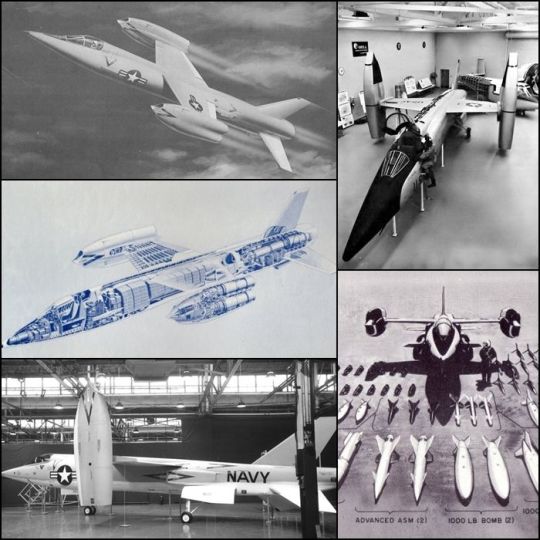
-Photo collage of the the D-188A mockup and concept art. | Illustration: Bell Aircraft
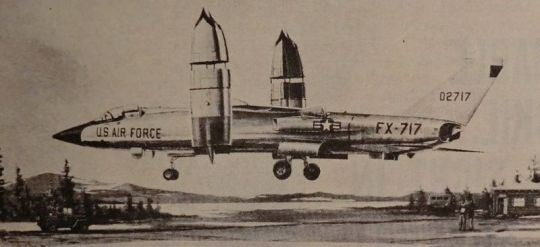
-Concept art of the XF-109 in hover. | Illustration: Bell Aircraft
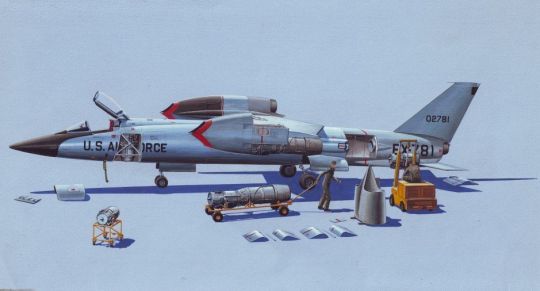
-Bell artwork of a XF-109 undergoing (simplified) maintenance. Taking care of eight jet engines would have been challenging, especially under austere conditions. | Illustration: Bell Aircraft
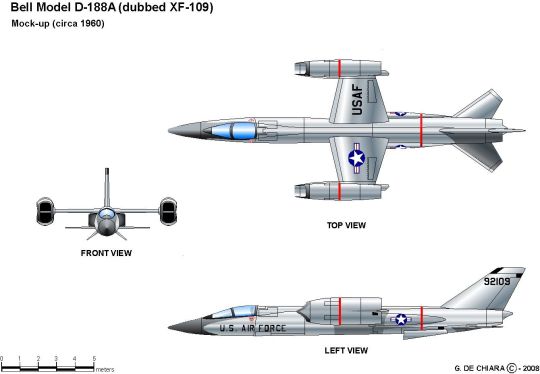
-Orthograph of the XF-109 in the 1960 configuration. | Illustration: G. De Chiara

-Illustration of the XF3L showing the subtle differences in the empennage. | Illustration: G. De Chiara
The mockup was completed in December 1960, and was displayed in both USAF and Navy markings. By this point however, interest in the program had cooled, with first the Navy then the USAF dropping out by 1961. It's unlikely that the plane would have met the somewhat (okay, very) unrealistic performance goals as stated, so an operational D-188/A would likely have been slower, had less range, and/or carried less of a payload.
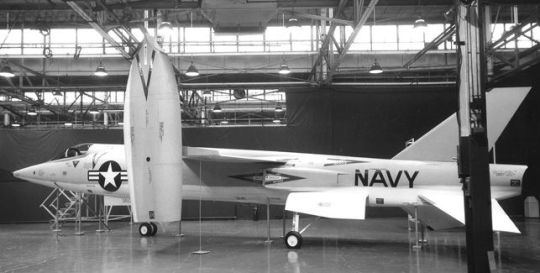
-The D-188A mockup in US Navy markings and with the engine pods in VTOL position. | Photo: Bell Aircraft
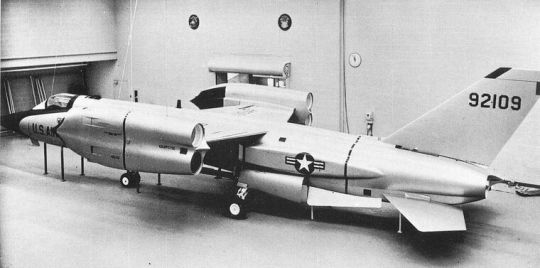
-The D-188A in XF-109 markings. The XF-109/XF3L mockup was a intriguing look at a future that was not to be. | Photo: Bell Aircraft
#aircraft#aviation#avgeek#airplanes#cold war#airplane#cold war history#coldwar#aviation history#usaf#bell aircraft#d188a#d 188a#xf109#xf 109#xf3l#us navy#usn#vtol#vstol
105 notes
·
View notes
Video
tumblr
Next generation air mail....
SAN DIEGO, CA (June 24, 2020) -- The first United States Navy CMV-22B Osprey approaches and lands at Naval Air Station North Island.
The CMV-22B Osprey replaces the older C-2A Greyhound cargo plane in the carrier onboard delivery (COD) role. The Osprey is a tiltrotor V/STOL aircraft that can takeoff and land as a helicopter but transit as a turboprop aircraft.
This version of the original MV-22B Osprey will haul mail, supplies, personnel, and, probably most importantly, replacement F-35 Lightning II fighter jet engines from airfields on shore to the Navy’s eleven nuclear-powered Nimitz- and Ford-class aircraft carriers (CVNs), and ten (eventually roughly twenty) Wasp- (LHDs) and America-class (LHAs) amphibious assault ships operating at sea....all F-35-variant fighter-jet-capable platforms.

In with the new....the CMV-22B Osprey.
Compared to the combat-ready MV-22B Ospreys, the logistics variant has extended operational range, a beyond line-of-sight HF radio, a public address system for passengers, and an improved lighting system for cargo loading. The CMV-22B will be capable of transporting up to 6,000 pounds (2,700 kg) of cargo/personnel out to a range of 1,300 miles (2,100 km).

Out with the old....a venerable C-2A COD flight landing aboard an aircraft carrier at sea.
The logistics-configured Osprey will provide the Navy with significant increases in capability and operational flexibility over the C-2A. CMV-22B operations can be either shore-based, “expeditionary”, or sea-based....and is a critical warfighting enabler, providing the time-sensitive logistics needed to support combat operations far from home.
The Navy currently plans to procure and deploy 38 of these game-changing logistics aircraft by 2026....concurrently retiring the remaining 27 C2As.
Note: The aircraft in the video and photos are finished in a high-visibility white-and-gray paint job....a color scheme the U.S. Navy uses to identify unarmed, noncombatant aircraft.
_________________________
>>Go FULL-SCREEN for a great closer view....
>>Video: Mass Communication Specialist 1st Class Timothy Wilson, USN
#U.S. Navy#Navy#USN#CMV-22B Osprey#MV-22B Osprey#logistics#aircraft carriers#aircraft#video#Mass Communication Specialist#F-35
53 notes
·
View notes
Video
EWR VJ 101 VTOL Jet Fighter at the Deutsches Museum Flugwerft Schleißheim by fsll2 Via Flickr: The EWR VJ 101 was an experimental German jet fighter VTOL tiltjet aircraft. VJ stood for "Versuchsjäger", (German for "Experimental Fighter").[1] It was to be the basis for a successor to the F-104G Starfighter, but was cancelled in 1968 after a five-year test program, during which two prototype aircraft were built. The VJ 101 was one of the first V/STOL designs to have the potential for eventual Mach 2 flight. Due to renovation work at Deutsches Museum Munich stored at Flugwerft Schleißheim until 2019
1 note
·
View note
Photo

VOLT CRUISER-1 (ボルトクルーザー)
Code: Ph-Red balance A Model No.: Ci – J Category: Attack Fighter Interceptor Operants: AW/2M Primary: Atmos Landing: STOL Height: 6.82 m Length: 17.73 m Width: 17.73 m Weight: 95 t Armaments: Crew Missiles, Crew Arrow, Vulcan Cannon, Crew Boomerang, Crew Cutters Target Definition: Radar-Sonar-Thermal Guidance Armor: Titanium-Platinum Alloy with Diamond Reinforcement Thermal Capacity: 1.43 millisol Shock Capacity: 15 Mt Control: Guardian Computer assisted with Manual Override
Source: Voltes V Club
#volt cruiser#volt crewzer#ボルトクルーザー#Kenichi Goh#Gō Ken'ichi#Steve Armstrong#剛健一#voltes 5#voltes v#super electromagnetic machine voltes v#VOLTUS V#voltus 5#vultus 5#vultus v#ボルテスV#超電磁マシーン ボルテスV#DX超合金魂 VOLT IN BOX 超電磁マシーン ボルテスV#DX超合金魂 ボルテスV
0 notes
Photo

Metal Slug X Slug Flyer V/STOL Aircraft Type F-07V 隼 #metalslugx#slugflyer#v/stol#aircraft#regulararmy#plasticmodel#plasticmodelkit#隼#billionsparkcraftsmanship#billionspark#fighter#games#webstagram#igers#instagood#instamood#instadaily#iphoneonly#insta_global#instagramhub#igersoftheday#insta_international#picoftheday https://www.instagram.com/p/CW-8jjeJ7WL/?utm_medium=tumblr
#metalslugx#slugflyer#v#aircraft#regulararmy#plasticmodel#plasticmodelkit#隼#billionsparkcraftsmanship#billionspark#fighter#games#webstagram#igers#instagood#instamood#instadaily#iphoneonly#insta_global#instagramhub#igersoftheday#insta_international#picoftheday
0 notes
Note
Now that things have settled a bit, do you think the F-35 program was worth it?
It depends on how you define “worth it.” Like, despite what every Russaboo will tell you, stealth is still relevant. So it’s great that we got a lightweight stealth fighter to complement the F-22. I am sure that the F-35 will prove many new tech concepts, in terms of avionics, that we wouldn’t have tried otherwise. It’s gonna replace a lot of shit that needed replacing. In general, a big net positive.
But I also think a lot of the important lessons we should’ve learned from the JSF program won’t stick. It’s ridiculous how much money we could’ve saved simply by no longer pretending the USMC is worth maintaining as a discrete military branch.
By far, the biggest stumbling block of the JSF program was shoehorning V/STOL tech into it for the Marines. If we didn’t have to make the F-35B, we would’ve saved an absurd amount of money.
The F-35B exists because of a series of tautologies that exist to justify the existence of the USMC. And because of that, we wind up in an absurd situation where the Navy’s Army needs an Air Force. We already have a Navy, an Army, and an Air Force. The Navy already has its own specialized shipborne aviation. But for some reason, despite all logic, we need the USMC.
Spoiler alert: We don’t. The USMC doesn’t train its troops in any way that gives them the True Edge against Army infantry. What, “every Marine a rifleman?” That’s something Marine POGs say to feel tough. Truth is even the Air Force makes everyone qual on the M16. You’re not hard just because you wear MARPAT.
Seen Generation Kill? You know that line, “if you want logistics, join the Army?” That shit is how the Marines will tell you they deliver the most bang for the taxpayer’s buck. But they don’t. They float to battle in Navy ships, they fly to the AOR in Air Force transports, and they’re fed and sheltered by Army logistics. Go figure that the guys priding themselves on not having shit are the US Mooch Corps.
But until we wake up, and stop drinking the Flavor-Aid, we’re going to be stuck paying for a completely superfluous military branch. And since we take it as a matter of fact that since it exists it must continue to exist, compatibility with it will continue to be a concern for every major platform going forward.
The F-35, like the V-22, could’ve been an object lesson in how we could’ve accepted that the future is now… but we’d rather bow to the tautological wisdom of the old men.
142 notes
·
View notes
Text

F-35 fighters leave the Middle East after deployment to deter Iran and Russia
Fernando Valduga By Fernando Valduga 10/07/2023 - 14:44 in Military, War Zones
The U.S. Air Force F-35 Lightning II stealth fighters, sent to the Middle East to prevent Iranian aggression in the Persian Gulf and react to Russian intimidation in the Syrian skies, have left the region, according to service officials.
"What the F-35s did was give us additional capacity," said the commander of the Air Force Central (AFCENT), Lieutenant General Alexus G. Grynkewich, to reporters on October 4 at a Defense Writers Group event.
The deployment was completed in late September, according to the 388ª Fighter Wing at Hill Air Base, Utah. All aircraft have left the Middle East and are "in transit home," according to a spokesman for the 388th Fighter Wing.
Operating as the 421º Air Expeditionary Squadron, the F-35 were first deployed on July 26, when fifth-generation fighters were rushed to the region by the Pentagon after Iranian attacks on commercial ships around the Strait of Hormuz, the strategic bottleneck between the Persian Gulf and the Gulf of Oman, through which 20% of the world's oil flows.
Additional U.S. Navy ships, led by the Bataan Amphibious Ready Group with thousands of Marines, followed the F-35. The amphibious assault ship USS Bataan brought more air power to the region with a squadron of short or vertical takeoff and landing Harriers (V/STOL).
The US still has the F-16 and A-10 in the region. However, the stealthy F-35 provided more advanced capabilities.

The F-35 allowed the U.S. to “continue to carry out the missions we were carrying out in Iraq and Syria and elsewhere in the region, and to increase what we were doing in support of the Navy, basically doing air combat patrols over the Strait of Hormuz,” said Grynkewich, who added that the Navy's detachment was particularly important.
“This increase in surface ships combined with our air power has dissuaded Iran from taking any action against maritime transport,” he said.
In addition to their mission in the Gulf, the F-35 were useful in discouraging Russian warplanes from chasing American aircraft in Syria. The F-35 also joined the U.S. allies in Syria, including flying with French Rafale fighters.
Russia's aggressive tactics emerged as a major concern in July, when Russian fighters launched flags that damaged U.S. MQ-9 drones that were carrying out missions against Islamic State militants.
After the U.S. released the video of Russian harassment and deployed the F-35, Russia moderated its tactics and became less aggressive.
"They still fly in airspace, but not directly above our forces, so I welcome this change in behavior," Grynkewich said. "With the flags being released on our MQ-9, we no longer see this behavior."

The U.S. military presence in the region is very modest compared to the years when Americans fought in Iraq and Afghanistan. But U.S. air operations over Syria were also reinforced by coalition partners, including the French and British.
“We are still at risk of terrorist attacks in our capitals or on our lands,” General Stéphane Mille, head of the French Air and Space Force, told journalists in September. "We are flying together."
Not all the challenges that the U.S. has faced come from opponents. Turkey, also a member of NATO, has been attacking Kurdish groups in northern Syria, which is responsible for a bomb attack in the capital Ankara on October 1, in operations that may put American troops at risk.
On the morning of October 5, a Turkish drone hit targets within a restrictive operating zone (ROZ) declared by the U.S. military, according to the Pentagon. The attacks reached one kilometer from U.S. forces, forcing them to protect themselves in bunkers.
When a Turkish drone returned to the area about four hours later and headed for U.S. forces, it was shot down by a U.S. F-16 half a kilometer away from U.S. personnel in an act of self-defense, according to U.S. authorities.
On October 6, the Turkish Ministry of Foreign Affairs minimized the episode in a statement, saying that its drone “was lost due to different technical evaluations in the conflict resolution mechanism with third parties”.

The biggest concern, however, remains Iran. Despite the departure of the F-35, which Grynkewich observed has always been planned to be “temporary”, the U.S. is prepared to flex forces for the region.
“My opinion is that the deterrence is temporal,” Grynkewich said of Iran. “We have increased strength in response to a specific threat. This shows the American commitment to the region. This shows that our American strategy has been, with our posture being less than before, we demonstrate the commitment to bring strength to great exercises for guarantee purposes or when a threat required it. And we certainly did that in this case."
Source: Air Force & Space Magazine
Tags: Military AviationF-35 Lightning IIUSAF - United States Air Force / U.S. Air ForceWar Zones - Middle East
Sharing
tweet
Fernando Valduga
Fernando Valduga
Aviation photographer and pilot since 1992, he has participated in several events and air operations, such as Cruzex, AirVenture, Daytona Airshow and FIDAE. He has work published in specialized aviation magazines in Brazil and abroad. Uses Canon equipment during his photographic work throughout the world of aviation.
Related news
MILITARY
After more than 60 years, the Indian Air Force defines retirement of its MiG-21
06/10/2023 - 20:49
HELICOPTERS
Czech Air Force receives new batch of AH-1Z Viper and UH-1Y Venom helicopters
06/10/2023 - 16:00
The 150º Rafale C fighter is preparing to leave the Dassault Aviation factory at Bordeaux-Mérignac airport to fly to the French Air Force aircraft technical specialization center in Mont-de-Marsan, where it will be upgraded to the latest F4.1 standard. (Photo: DGA)
MILITARY
France receives the 150º Rafale C fighter
06/10/2023 - 14:00
Austin Butler in "Masters of the Air", premiering on January 26, 2024 on Apple TV+.
HISTORY
New Apple TV+ series arrives in January talking about 'Mighty Eighth' in World War II
06/10/2023 - 12:00
MILITARY
Drone XQ-58A Valkyrie flies with the U.S. Marine Corps
06/10/2023 - 09:00
MILITARY
Order book for F-16 fighters reaches 148, close to the current 156 orders of the F-35
06/10/2023 - 08:09
11 notes
·
View notes
Text
The EWR VJ 101 was an experimental German jet fighter vertical takeoff/landing (VTOL) tiltjet aircraft. VJ stood for Versuchsjäger, (German for "Experimental Fighter"). The VJ 101 was one of the first V/STOL designs to have the potential for eventual Mach 2 flight.
During the 1950s, as various nations took an interest in developing VTOL-capable aircraft, the German Federal Government issued a request to the nation's recently revived aviation industries for them to study possible designs for such aircraft. In response, in 1960, German engine manufacturer MAN Turbo commenced work on a suitable engine in close cooperation with British engine manufacturer Rolls-Royce Limited. Likewise, aircraft firms Heinkel, Bölkow and Messerschmitt performed their own studies before coming together to form a joint venture company, EWR, for the purpose of developing and manufacturing their design for a supersonic VTOL fighter aircraft, which was soon designated as the VJ 101 D.
...
[wikipedia]

118 notes
·
View notes